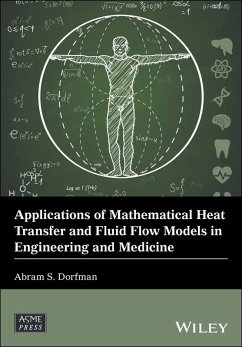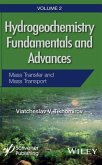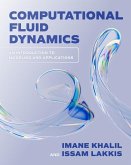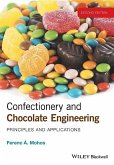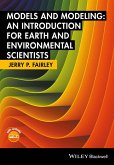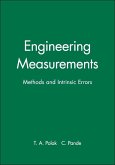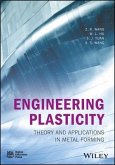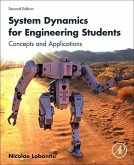Abram S Dorfman
Applications of Mathematical Heat Transfer and Fluid Flow Models in Engineering and Medicine
Abram S Dorfman
Applications of Mathematical Heat Transfer and Fluid Flow Models in Engineering and Medicine
- Gebundenes Buch
- Merkliste
- Auf die Merkliste
- Bewerten Bewerten
- Teilen
- Produkt teilen
- Produkterinnerung
- Produkterinnerung
Applications of mathematical heat transfer and fluid flow models in engineering and medicine Abram S. Dorfman, University of Michigan, USA Engineering and medical applications of cutting-edge heat and flow models This book presents innovative efficient methods in fluid flow and heat transfer developed and widely used over the last fifty years. The analysis is focused on mathematical models which are an essential part of any research effort as they demonstrate the validity of the results obtained. The universality of mathematics allows consideration of engineering and biological problems from…mehr
Andere Kunden interessierten sich auch für
![Hydrogeochemistry Fundamentals and Advances, Mass Transfer and Mass Transport Hydrogeochemistry Fundamentals and Advances, Mass Transfer and Mass Transport]() Viatcheslav V TikhomirovHydrogeochemistry Fundamentals and Advances, Mass Transfer and Mass Transport259,99 €
Viatcheslav V TikhomirovHydrogeochemistry Fundamentals and Advances, Mass Transfer and Mass Transport259,99 €![Computational Fluid Dynamics: An Introduction to Modeling and Applications Computational Fluid Dynamics: An Introduction to Modeling and Applications]() Imane KhalilComputational Fluid Dynamics: An Introduction to Modeling and Applications79,99 €
Imane KhalilComputational Fluid Dynamics: An Introduction to Modeling and Applications79,99 €![Confectionery and Chocolate Engineering Confectionery and Chocolate Engineering]() Ferenc A MohosConfectionery and Chocolate Engineering285,99 €
Ferenc A MohosConfectionery and Chocolate Engineering285,99 €![Models and Modeling Models and Modeling]() Jerry P FairleyModels and Modeling88,99 €
Jerry P FairleyModels and Modeling88,99 €![Engineering Measurements Engineering Measurements]() T A PolakEngineering Measurements176,99 €
T A PolakEngineering Measurements176,99 €![Engineering Plasticity Engineering Plasticity]() Z R WangEngineering Plasticity175,99 €
Z R WangEngineering Plasticity175,99 €![System Dynamics for Engineering Students System Dynamics for Engineering Students]() Nicolae LobontiuSystem Dynamics for Engineering Students150,99 €
Nicolae LobontiuSystem Dynamics for Engineering Students150,99 €-
-
-
Applications of mathematical heat transfer and fluid flow models in engineering and medicine Abram S. Dorfman, University of Michigan, USA Engineering and medical applications of cutting-edge heat and flow models This book presents innovative efficient methods in fluid flow and heat transfer developed and widely used over the last fifty years. The analysis is focused on mathematical models which are an essential part of any research effort as they demonstrate the validity of the results obtained. The universality of mathematics allows consideration of engineering and biological problems from one point of view using similar models. In this book, the current situation of applications of modern mathematical models is outlined in three parts. Part I offers in depth coverage of the applications of contemporary conjugate heat transfer models in various industrial and technological processes, from aerospace and nuclear reactors to drying and food processing. In Part II the theory and application of two recently developed models in fluid flow are considered: the similar conjugate model for simulation of biological systems, including flows in human organs, and applications of the latest developments in turbulence simulation by direct solution of Navier-Stokes equations, including flows around aircraft. Part III proposes fundamentals of laminar and turbulent flows and applied mathematics methods. The discussion is complimented by 365 examples selected from a list of 448 cited papers, 239 exercises and 136 commentaries. Key features: * Peristaltic flows in normal and pathologic human organs. * Modeling flows around aircraft at high Reynolds numbers. * Special mathematical exercises allow the reader to complete expressions derivation following directions from the text. * Procedure for preliminary choice between conjugate and common simple methods for particular problem solutions. * Criterions of conjugation, definition of semi-conjugate solutions. This book is an ideal reference for graduate and post-graduate students and engineers.
Hinweis: Dieser Artikel kann nur an eine deutsche Lieferadresse ausgeliefert werden.
Hinweis: Dieser Artikel kann nur an eine deutsche Lieferadresse ausgeliefert werden.
Produktdetails
- Produktdetails
- Verlag: Wiley
- Seitenzahl: 456
- Erscheinungstermin: 6. Februar 2017
- Englisch
- Abmessung: 246mm x 168mm x 25mm
- Gewicht: 839g
- ISBN-13: 9781119320562
- ISBN-10: 1119320569
- Artikelnr.: 47486380
- Herstellerkennzeichnung
- Libri GmbH
- Europaallee 1
- 36244 Bad Hersfeld
- gpsr@libri.de
- Verlag: Wiley
- Seitenzahl: 456
- Erscheinungstermin: 6. Februar 2017
- Englisch
- Abmessung: 246mm x 168mm x 25mm
- Gewicht: 839g
- ISBN-13: 9781119320562
- ISBN-10: 1119320569
- Artikelnr.: 47486380
- Herstellerkennzeichnung
- Libri GmbH
- Europaallee 1
- 36244 Bad Hersfeld
- gpsr@libri.de
Abram S. Dorfman, Doctor of Science, Ph. D. was born in 1923 in Kiev. He was a leading scientist in fluid mechanic and heat transfer at the Institute of Thermophiysics of the Ukrainian Academy of Science and associate editor of Promyshlennaya Teploteknika translated by Wiley as Applied Thermal Science. He earned his Ph.D. with a thesis Investigation of Supersonic Flows in Nozzles and received a Doctor of Science degree with a thesis and a book Heat Transfer in Flows around the Nonisothermal bodies. He emigrated to the United States in 1990 and continues his research as a visiting professor at the University of Michigan. During that time, he published several articles in leading American journals and two books. Dr. Dorfman has been an adviser to Ph. D. students and has published more than 140 papers and four books. More than 50 of his papers published in Russian have been translated into English.
Series Preface xiii
Preface xv
Acknowledgments xxvii
About the Author xxix
Nomenclature xxxi
Part I APPLICATIONS IN CONJUGATE HEAT TRANSFER
Introduction 1
When and why Conjugate Procedure is Essential 1
A Core of Conjugation 3
1 Universal Functions for Nonisothermal and Conjugate Heat Transfer 5
1.1 Formulation of Conjugate Heat Transfer Problem 5
1.2 Methods of Conjugation 9
1.2.1 Numerical Methods 9
1.2.2 Using Universal Functions 10
1.3 Integral Universal Function (Duhamel's Integral) 10
1.3.1 Duhamel's Integral Derivation 10
1.3.2 Influence Function 12
1.4 Differential Universal Function (Series of Derivatives) 13
1.5 General Forms of Universal Function 15
Exercises 1.1-1.32 16
1.6 Coefficients gk and Exponents C1 and C2 for Laminar Flow 19
1.6.1 Features of Coefficients gk of the Differential Universal Function
19
1.6.2 Estimation of Exponents C1 and C2 for Integral Universal Function 22
1.7 Universal Functions for Turbulent Flow 24
Exercises 1.33-1.47 27
1.8 Universal Functions for Compressible Low 28
1.9 Universal Functions for Power-Law Non-Newtonian Fluids 29
1.10 Universal Functions for Moving Continuous Sheet 32
1.11 Universal Functions for a Plate with Arbitrary Unsteady Temperature
Distribution 34
1.12 Universal Functions for an Axisymmetric Body 35
1.13 Inverse Universal Function 36
1.13.1 Differential Inverse Universal Function 36
1.13.2 Integral Inverse Universal Function 37
1.14 Universal Function for Recovery Factor 38
Exercises 1.48-1.75 41
2 Application of Universal Functions 45
2.1 The Rate of Conjugate Heat Transfer Intensity 45
2.1.1 Effect of Temperature Head Distribution 45
2.1.2 Effect of Turbulence 50
2.1.3 Effect of Time-Variable Temperature Head 58
2.1.4 Effects of Conditions and Parameters in the Inverse Problems 60
2.1.5 Effect of Non-Newtonian Power-Law Rheology Fluid Behavior 66
2.1.6 Effect of Mechanical Energy Dissipation 67
2.1.7 Effect of Biot Number as a Measure of Problem Conjugation 68
Exercises 2.1-2.33 70
2.2 The General Convective Boundary Conditions 73
2.2.1 Accuracy of Boundary Condition of the Third Kind 73
2.2.2 Conjugate Problem as an Equivalent Conduction Problem 76
2.3 The Gradient Analogy 78
2.4 Heat Flux Inversion 82
2.5 Zero Heat Transfer Surfaces 84
2.6 Optimization in Heat Transfer Problems 86
2.6.1 Problem Formulation 87
2.6.2 Problem Formulation 89
2.6.3 Problem Formulation 92
Exercises 2.34-2.82 95
3 Application of Conjugate Heat Transfer Models in External and Internal
Flows 102
3.1 External Flows 102
3.1.1 Conjugate Heat Transfer in Flows Past Thin Plates 102
Exercises 3.1-3.38 123
3.1.2 Conjugate Heat Transfer in Flows Past Bodies 126
3.2 Internal Flows-Conjugate Heat Transfer in Pipes and Channels Flows 141
4 Specific Applications of Conjugate Heat Transfer Models 155
4.1 Heat Exchangers and Finned Surfaces 155
4.1.1 Heat Exchange Between Two Fluids Separated by a Wall (Overall Heat
Transfer Coefficient) 155
4.1.2 Applicability of One-Dimensional Models and Two-Dimensional Effects
166
4.1.3 Heat Exchanger Models 170
4.1.4 Finned Surfaces 175
4.2 Thermal Treatment and Cooling Systems 180
4.2.1 Treatment of Continuous Materials 180
4.2.2 Cooling Systems 185
4.3 Simulation of Industrial Processes 196
4.4 Technology Processes 202
4.4.1 Heat and Mass Transfer in Multiphase Processes 202
4.4.2 Drying and Food Processing 208
Summary of Part I 219
Effect of Conjugation 219
Part II APPLICATIONS IN FLUID FLOW
5 Two Advanced Methods 225
5.1 Conjugate Models of Peristaltic Flow 225
5.1.1 Model Formulation 225
5.1.2 The First Investigations 228
5.1.3 Semi-Conjugate Solutions 230
Exercises 5.1-5.19 236
5.1.4 Conjugate Solutions 237
Exercises 5.20-5.31 243
5.2 Methods of Turbulence Simulation 244
5.2.1 Introduction 244
5.2.2 Direct Numerical Simulation 244
5.2.3 Large Eddy Simulation 245
5.2.4 Detached Eddy Simulation 247
5.2.5 Chaos Theory 249
Exercises 5.32-5.44 249
6 Applications of Fluid Flow Modern Models 251
6.1 Applications of Fluid Flow Models in Biology and Medicine 251
6.1.1 Blood Flow in Normal and Pathologic Vessels 251
6.1.2 Abnormal Flows in Disordered Human Organs 261
6.1.3 Simulation of Biological Transport Processes 267
6.2 Application of Fluid Flow Models in Engineering 273
6.2.1 Application of Peristaltic Flow Models 273
6.2.2 Applications of Direct Simulation of Turbulence 278
Part III FOUNDATIONS OF FLUID FLOW AND HEAT TRANSFER
7 Laminar Fluid Flow and Heat Transfer 295
7.1 Navier-Stokes, Energy, and Mass Transfer Equations 295
7.1.1 Two Types of Transport Mechanism: Analogy Between Transfer Processes
295
7.1.2 Different Forms of Navier-Stokes, Energy, and Diffusion Equations
297
7.2 Initial and Boundary Counditions 302
7.3 Exact Solutions of Navier-Stokes and Energy Equations 303
7.3.1 Two Stokes Problems 303
7.3.2 Steady Flow in Channels and in a Circular Tube 304
7.3.3 Stagnation Point Flow (Hiemenz Flow) 304
7.3.4 Couette Flow in a Channel with Heated Walls 306
7.3.5 Adiabatic Wall Temperature 306
7.3.6 Temperature Distributions in Channels and in a Tube 306
7.4 Cases of Small and Large Reynolds and Peclet Numbers 307
7.4.1 Creeping Approximation (Small Reynolds and Peclet Numbers) 307
7.4.2 Stokes Flow Past Sphere 308
7.4.3 Oseen's Approximation 308
7.4.4 Boundary Layer Approximation (Large Reynolds and Peclet Numbers) 309
7.5 Exact Solutions of Boundary Layer Equations 315
7.5.1 Flow and Heat Transfer on Isothermal Semi-infinite Flat Plate 315
7.5.2 Self-Similar Flows of Dynamic and Thermal Boundary Layers 319
7.6 Approximate Karman-Pohlhausen Integral Method 320
7.6.1 Approximate Friction and Heat Transfer on a Flat Plate 320
7.6.2 Flows with Pressure Gradients 322
7.7 Limiting Cases of Prandtl Number 323
7.8 Natural Convection 324
8 Turbulent Fluid Flow and Heat Transfer 327
8.1 Transition from Laminar to Turbulent Flow 327
8.2 Reynolds Averaged Navier-Stokes Equation (RANS) 328
8.2.1 Some Physical Aspects 328
8.2.2 Reynolds Averaging 329
8.2.3 Reynolds Equations and Reynolds Stresses 330
8.3 Algebraic Models 331
8.3.1 Prandtl's Mixing-Length Hypothesis 331
8.3.2 Modern Structure of Velocity Profile in Turbulent Boundary Layer 332
8.3.3 Mellor-Gibson Model 334
8.3.4 Cebeci-Smith Model 335
8.3.5 Baldwin-Lomax Model 336
8.3.6 Application of the Algebraic Models 337
8.3.7 The 1/2 Equation Model 338
8.3.8 Applicability of the Algebraic Models 339
8.4 One-Equation and Two-Equations Models 339
8.4.1 Turbulence Kinetic Energy Equation 340
8.4.2 One-Equation Models 340
8.4.3 Two-Equation Models 341
8.4.4 Applicability of the One-Equation and Two-Equation Models 343
9 Analytical and Numerical Methods in Fluid Flow and Heat Transfer 344
Analytical Methods 344
9.1 Solutions Using Error Functions 344
9.2 Method of Separation Variables 345
9.2.1 General Approach, Homogeneous, and Inhomogeneous Problems 346
9.2.2 One-Dimensional Unsteady Problems 347
9.2.3 Orthogonal Eigenfunctions 348
9.2.4 Two-Dimensional Steady Problems 351
9.3 Integral Transforms 353
9.3.1 Fourier Transform 353
9.3.2 Laplace Transform 356
9.4 Green's Function Method 358
Numerical Methods 361
9.5 What Method is Proper? 361
9.6 Approximate Methods for Solving Differential Equations 363
9.7 Computing Flow and Heat Transfer Characteristics 368
9.7.1 Control-Volume Finite-Difference Method 368
9.7.2 Control-Volume Finite-Element Method 371
10 Conclusion 373
References 376
Author Index 397
Subject Index 409
Preface xv
Acknowledgments xxvii
About the Author xxix
Nomenclature xxxi
Part I APPLICATIONS IN CONJUGATE HEAT TRANSFER
Introduction 1
When and why Conjugate Procedure is Essential 1
A Core of Conjugation 3
1 Universal Functions for Nonisothermal and Conjugate Heat Transfer 5
1.1 Formulation of Conjugate Heat Transfer Problem 5
1.2 Methods of Conjugation 9
1.2.1 Numerical Methods 9
1.2.2 Using Universal Functions 10
1.3 Integral Universal Function (Duhamel's Integral) 10
1.3.1 Duhamel's Integral Derivation 10
1.3.2 Influence Function 12
1.4 Differential Universal Function (Series of Derivatives) 13
1.5 General Forms of Universal Function 15
Exercises 1.1-1.32 16
1.6 Coefficients gk and Exponents C1 and C2 for Laminar Flow 19
1.6.1 Features of Coefficients gk of the Differential Universal Function
19
1.6.2 Estimation of Exponents C1 and C2 for Integral Universal Function 22
1.7 Universal Functions for Turbulent Flow 24
Exercises 1.33-1.47 27
1.8 Universal Functions for Compressible Low 28
1.9 Universal Functions for Power-Law Non-Newtonian Fluids 29
1.10 Universal Functions for Moving Continuous Sheet 32
1.11 Universal Functions for a Plate with Arbitrary Unsteady Temperature
Distribution 34
1.12 Universal Functions for an Axisymmetric Body 35
1.13 Inverse Universal Function 36
1.13.1 Differential Inverse Universal Function 36
1.13.2 Integral Inverse Universal Function 37
1.14 Universal Function for Recovery Factor 38
Exercises 1.48-1.75 41
2 Application of Universal Functions 45
2.1 The Rate of Conjugate Heat Transfer Intensity 45
2.1.1 Effect of Temperature Head Distribution 45
2.1.2 Effect of Turbulence 50
2.1.3 Effect of Time-Variable Temperature Head 58
2.1.4 Effects of Conditions and Parameters in the Inverse Problems 60
2.1.5 Effect of Non-Newtonian Power-Law Rheology Fluid Behavior 66
2.1.6 Effect of Mechanical Energy Dissipation 67
2.1.7 Effect of Biot Number as a Measure of Problem Conjugation 68
Exercises 2.1-2.33 70
2.2 The General Convective Boundary Conditions 73
2.2.1 Accuracy of Boundary Condition of the Third Kind 73
2.2.2 Conjugate Problem as an Equivalent Conduction Problem 76
2.3 The Gradient Analogy 78
2.4 Heat Flux Inversion 82
2.5 Zero Heat Transfer Surfaces 84
2.6 Optimization in Heat Transfer Problems 86
2.6.1 Problem Formulation 87
2.6.2 Problem Formulation 89
2.6.3 Problem Formulation 92
Exercises 2.34-2.82 95
3 Application of Conjugate Heat Transfer Models in External and Internal
Flows 102
3.1 External Flows 102
3.1.1 Conjugate Heat Transfer in Flows Past Thin Plates 102
Exercises 3.1-3.38 123
3.1.2 Conjugate Heat Transfer in Flows Past Bodies 126
3.2 Internal Flows-Conjugate Heat Transfer in Pipes and Channels Flows 141
4 Specific Applications of Conjugate Heat Transfer Models 155
4.1 Heat Exchangers and Finned Surfaces 155
4.1.1 Heat Exchange Between Two Fluids Separated by a Wall (Overall Heat
Transfer Coefficient) 155
4.1.2 Applicability of One-Dimensional Models and Two-Dimensional Effects
166
4.1.3 Heat Exchanger Models 170
4.1.4 Finned Surfaces 175
4.2 Thermal Treatment and Cooling Systems 180
4.2.1 Treatment of Continuous Materials 180
4.2.2 Cooling Systems 185
4.3 Simulation of Industrial Processes 196
4.4 Technology Processes 202
4.4.1 Heat and Mass Transfer in Multiphase Processes 202
4.4.2 Drying and Food Processing 208
Summary of Part I 219
Effect of Conjugation 219
Part II APPLICATIONS IN FLUID FLOW
5 Two Advanced Methods 225
5.1 Conjugate Models of Peristaltic Flow 225
5.1.1 Model Formulation 225
5.1.2 The First Investigations 228
5.1.3 Semi-Conjugate Solutions 230
Exercises 5.1-5.19 236
5.1.4 Conjugate Solutions 237
Exercises 5.20-5.31 243
5.2 Methods of Turbulence Simulation 244
5.2.1 Introduction 244
5.2.2 Direct Numerical Simulation 244
5.2.3 Large Eddy Simulation 245
5.2.4 Detached Eddy Simulation 247
5.2.5 Chaos Theory 249
Exercises 5.32-5.44 249
6 Applications of Fluid Flow Modern Models 251
6.1 Applications of Fluid Flow Models in Biology and Medicine 251
6.1.1 Blood Flow in Normal and Pathologic Vessels 251
6.1.2 Abnormal Flows in Disordered Human Organs 261
6.1.3 Simulation of Biological Transport Processes 267
6.2 Application of Fluid Flow Models in Engineering 273
6.2.1 Application of Peristaltic Flow Models 273
6.2.2 Applications of Direct Simulation of Turbulence 278
Part III FOUNDATIONS OF FLUID FLOW AND HEAT TRANSFER
7 Laminar Fluid Flow and Heat Transfer 295
7.1 Navier-Stokes, Energy, and Mass Transfer Equations 295
7.1.1 Two Types of Transport Mechanism: Analogy Between Transfer Processes
295
7.1.2 Different Forms of Navier-Stokes, Energy, and Diffusion Equations
297
7.2 Initial and Boundary Counditions 302
7.3 Exact Solutions of Navier-Stokes and Energy Equations 303
7.3.1 Two Stokes Problems 303
7.3.2 Steady Flow in Channels and in a Circular Tube 304
7.3.3 Stagnation Point Flow (Hiemenz Flow) 304
7.3.4 Couette Flow in a Channel with Heated Walls 306
7.3.5 Adiabatic Wall Temperature 306
7.3.6 Temperature Distributions in Channels and in a Tube 306
7.4 Cases of Small and Large Reynolds and Peclet Numbers 307
7.4.1 Creeping Approximation (Small Reynolds and Peclet Numbers) 307
7.4.2 Stokes Flow Past Sphere 308
7.4.3 Oseen's Approximation 308
7.4.4 Boundary Layer Approximation (Large Reynolds and Peclet Numbers) 309
7.5 Exact Solutions of Boundary Layer Equations 315
7.5.1 Flow and Heat Transfer on Isothermal Semi-infinite Flat Plate 315
7.5.2 Self-Similar Flows of Dynamic and Thermal Boundary Layers 319
7.6 Approximate Karman-Pohlhausen Integral Method 320
7.6.1 Approximate Friction and Heat Transfer on a Flat Plate 320
7.6.2 Flows with Pressure Gradients 322
7.7 Limiting Cases of Prandtl Number 323
7.8 Natural Convection 324
8 Turbulent Fluid Flow and Heat Transfer 327
8.1 Transition from Laminar to Turbulent Flow 327
8.2 Reynolds Averaged Navier-Stokes Equation (RANS) 328
8.2.1 Some Physical Aspects 328
8.2.2 Reynolds Averaging 329
8.2.3 Reynolds Equations and Reynolds Stresses 330
8.3 Algebraic Models 331
8.3.1 Prandtl's Mixing-Length Hypothesis 331
8.3.2 Modern Structure of Velocity Profile in Turbulent Boundary Layer 332
8.3.3 Mellor-Gibson Model 334
8.3.4 Cebeci-Smith Model 335
8.3.5 Baldwin-Lomax Model 336
8.3.6 Application of the Algebraic Models 337
8.3.7 The 1/2 Equation Model 338
8.3.8 Applicability of the Algebraic Models 339
8.4 One-Equation and Two-Equations Models 339
8.4.1 Turbulence Kinetic Energy Equation 340
8.4.2 One-Equation Models 340
8.4.3 Two-Equation Models 341
8.4.4 Applicability of the One-Equation and Two-Equation Models 343
9 Analytical and Numerical Methods in Fluid Flow and Heat Transfer 344
Analytical Methods 344
9.1 Solutions Using Error Functions 344
9.2 Method of Separation Variables 345
9.2.1 General Approach, Homogeneous, and Inhomogeneous Problems 346
9.2.2 One-Dimensional Unsteady Problems 347
9.2.3 Orthogonal Eigenfunctions 348
9.2.4 Two-Dimensional Steady Problems 351
9.3 Integral Transforms 353
9.3.1 Fourier Transform 353
9.3.2 Laplace Transform 356
9.4 Green's Function Method 358
Numerical Methods 361
9.5 What Method is Proper? 361
9.6 Approximate Methods for Solving Differential Equations 363
9.7 Computing Flow and Heat Transfer Characteristics 368
9.7.1 Control-Volume Finite-Difference Method 368
9.7.2 Control-Volume Finite-Element Method 371
10 Conclusion 373
References 376
Author Index 397
Subject Index 409
Series Preface xiii
Preface xv
Acknowledgments xxvii
About the Author xxix
Nomenclature xxxi
Part I APPLICATIONS IN CONJUGATE HEAT TRANSFER
Introduction 1
When and why Conjugate Procedure is Essential 1
A Core of Conjugation 3
1 Universal Functions for Nonisothermal and Conjugate Heat Transfer 5
1.1 Formulation of Conjugate Heat Transfer Problem 5
1.2 Methods of Conjugation 9
1.2.1 Numerical Methods 9
1.2.2 Using Universal Functions 10
1.3 Integral Universal Function (Duhamel's Integral) 10
1.3.1 Duhamel's Integral Derivation 10
1.3.2 Influence Function 12
1.4 Differential Universal Function (Series of Derivatives) 13
1.5 General Forms of Universal Function 15
Exercises 1.1-1.32 16
1.6 Coefficients gk and Exponents C1 and C2 for Laminar Flow 19
1.6.1 Features of Coefficients gk of the Differential Universal Function
19
1.6.2 Estimation of Exponents C1 and C2 for Integral Universal Function 22
1.7 Universal Functions for Turbulent Flow 24
Exercises 1.33-1.47 27
1.8 Universal Functions for Compressible Low 28
1.9 Universal Functions for Power-Law Non-Newtonian Fluids 29
1.10 Universal Functions for Moving Continuous Sheet 32
1.11 Universal Functions for a Plate with Arbitrary Unsteady Temperature
Distribution 34
1.12 Universal Functions for an Axisymmetric Body 35
1.13 Inverse Universal Function 36
1.13.1 Differential Inverse Universal Function 36
1.13.2 Integral Inverse Universal Function 37
1.14 Universal Function for Recovery Factor 38
Exercises 1.48-1.75 41
2 Application of Universal Functions 45
2.1 The Rate of Conjugate Heat Transfer Intensity 45
2.1.1 Effect of Temperature Head Distribution 45
2.1.2 Effect of Turbulence 50
2.1.3 Effect of Time-Variable Temperature Head 58
2.1.4 Effects of Conditions and Parameters in the Inverse Problems 60
2.1.5 Effect of Non-Newtonian Power-Law Rheology Fluid Behavior 66
2.1.6 Effect of Mechanical Energy Dissipation 67
2.1.7 Effect of Biot Number as a Measure of Problem Conjugation 68
Exercises 2.1-2.33 70
2.2 The General Convective Boundary Conditions 73
2.2.1 Accuracy of Boundary Condition of the Third Kind 73
2.2.2 Conjugate Problem as an Equivalent Conduction Problem 76
2.3 The Gradient Analogy 78
2.4 Heat Flux Inversion 82
2.5 Zero Heat Transfer Surfaces 84
2.6 Optimization in Heat Transfer Problems 86
2.6.1 Problem Formulation 87
2.6.2 Problem Formulation 89
2.6.3 Problem Formulation 92
Exercises 2.34-2.82 95
3 Application of Conjugate Heat Transfer Models in External and Internal
Flows 102
3.1 External Flows 102
3.1.1 Conjugate Heat Transfer in Flows Past Thin Plates 102
Exercises 3.1-3.38 123
3.1.2 Conjugate Heat Transfer in Flows Past Bodies 126
3.2 Internal Flows-Conjugate Heat Transfer in Pipes and Channels Flows 141
4 Specific Applications of Conjugate Heat Transfer Models 155
4.1 Heat Exchangers and Finned Surfaces 155
4.1.1 Heat Exchange Between Two Fluids Separated by a Wall (Overall Heat
Transfer Coefficient) 155
4.1.2 Applicability of One-Dimensional Models and Two-Dimensional Effects
166
4.1.3 Heat Exchanger Models 170
4.1.4 Finned Surfaces 175
4.2 Thermal Treatment and Cooling Systems 180
4.2.1 Treatment of Continuous Materials 180
4.2.2 Cooling Systems 185
4.3 Simulation of Industrial Processes 196
4.4 Technology Processes 202
4.4.1 Heat and Mass Transfer in Multiphase Processes 202
4.4.2 Drying and Food Processing 208
Summary of Part I 219
Effect of Conjugation 219
Part II APPLICATIONS IN FLUID FLOW
5 Two Advanced Methods 225
5.1 Conjugate Models of Peristaltic Flow 225
5.1.1 Model Formulation 225
5.1.2 The First Investigations 228
5.1.3 Semi-Conjugate Solutions 230
Exercises 5.1-5.19 236
5.1.4 Conjugate Solutions 237
Exercises 5.20-5.31 243
5.2 Methods of Turbulence Simulation 244
5.2.1 Introduction 244
5.2.2 Direct Numerical Simulation 244
5.2.3 Large Eddy Simulation 245
5.2.4 Detached Eddy Simulation 247
5.2.5 Chaos Theory 249
Exercises 5.32-5.44 249
6 Applications of Fluid Flow Modern Models 251
6.1 Applications of Fluid Flow Models in Biology and Medicine 251
6.1.1 Blood Flow in Normal and Pathologic Vessels 251
6.1.2 Abnormal Flows in Disordered Human Organs 261
6.1.3 Simulation of Biological Transport Processes 267
6.2 Application of Fluid Flow Models in Engineering 273
6.2.1 Application of Peristaltic Flow Models 273
6.2.2 Applications of Direct Simulation of Turbulence 278
Part III FOUNDATIONS OF FLUID FLOW AND HEAT TRANSFER
7 Laminar Fluid Flow and Heat Transfer 295
7.1 Navier-Stokes, Energy, and Mass Transfer Equations 295
7.1.1 Two Types of Transport Mechanism: Analogy Between Transfer Processes
295
7.1.2 Different Forms of Navier-Stokes, Energy, and Diffusion Equations
297
7.2 Initial and Boundary Counditions 302
7.3 Exact Solutions of Navier-Stokes and Energy Equations 303
7.3.1 Two Stokes Problems 303
7.3.2 Steady Flow in Channels and in a Circular Tube 304
7.3.3 Stagnation Point Flow (Hiemenz Flow) 304
7.3.4 Couette Flow in a Channel with Heated Walls 306
7.3.5 Adiabatic Wall Temperature 306
7.3.6 Temperature Distributions in Channels and in a Tube 306
7.4 Cases of Small and Large Reynolds and Peclet Numbers 307
7.4.1 Creeping Approximation (Small Reynolds and Peclet Numbers) 307
7.4.2 Stokes Flow Past Sphere 308
7.4.3 Oseen's Approximation 308
7.4.4 Boundary Layer Approximation (Large Reynolds and Peclet Numbers) 309
7.5 Exact Solutions of Boundary Layer Equations 315
7.5.1 Flow and Heat Transfer on Isothermal Semi-infinite Flat Plate 315
7.5.2 Self-Similar Flows of Dynamic and Thermal Boundary Layers 319
7.6 Approximate Karman-Pohlhausen Integral Method 320
7.6.1 Approximate Friction and Heat Transfer on a Flat Plate 320
7.6.2 Flows with Pressure Gradients 322
7.7 Limiting Cases of Prandtl Number 323
7.8 Natural Convection 324
8 Turbulent Fluid Flow and Heat Transfer 327
8.1 Transition from Laminar to Turbulent Flow 327
8.2 Reynolds Averaged Navier-Stokes Equation (RANS) 328
8.2.1 Some Physical Aspects 328
8.2.2 Reynolds Averaging 329
8.2.3 Reynolds Equations and Reynolds Stresses 330
8.3 Algebraic Models 331
8.3.1 Prandtl's Mixing-Length Hypothesis 331
8.3.2 Modern Structure of Velocity Profile in Turbulent Boundary Layer 332
8.3.3 Mellor-Gibson Model 334
8.3.4 Cebeci-Smith Model 335
8.3.5 Baldwin-Lomax Model 336
8.3.6 Application of the Algebraic Models 337
8.3.7 The 1/2 Equation Model 338
8.3.8 Applicability of the Algebraic Models 339
8.4 One-Equation and Two-Equations Models 339
8.4.1 Turbulence Kinetic Energy Equation 340
8.4.2 One-Equation Models 340
8.4.3 Two-Equation Models 341
8.4.4 Applicability of the One-Equation and Two-Equation Models 343
9 Analytical and Numerical Methods in Fluid Flow and Heat Transfer 344
Analytical Methods 344
9.1 Solutions Using Error Functions 344
9.2 Method of Separation Variables 345
9.2.1 General Approach, Homogeneous, and Inhomogeneous Problems 346
9.2.2 One-Dimensional Unsteady Problems 347
9.2.3 Orthogonal Eigenfunctions 348
9.2.4 Two-Dimensional Steady Problems 351
9.3 Integral Transforms 353
9.3.1 Fourier Transform 353
9.3.2 Laplace Transform 356
9.4 Green's Function Method 358
Numerical Methods 361
9.5 What Method is Proper? 361
9.6 Approximate Methods for Solving Differential Equations 363
9.7 Computing Flow and Heat Transfer Characteristics 368
9.7.1 Control-Volume Finite-Difference Method 368
9.7.2 Control-Volume Finite-Element Method 371
10 Conclusion 373
References 376
Author Index 397
Subject Index 409
Preface xv
Acknowledgments xxvii
About the Author xxix
Nomenclature xxxi
Part I APPLICATIONS IN CONJUGATE HEAT TRANSFER
Introduction 1
When and why Conjugate Procedure is Essential 1
A Core of Conjugation 3
1 Universal Functions for Nonisothermal and Conjugate Heat Transfer 5
1.1 Formulation of Conjugate Heat Transfer Problem 5
1.2 Methods of Conjugation 9
1.2.1 Numerical Methods 9
1.2.2 Using Universal Functions 10
1.3 Integral Universal Function (Duhamel's Integral) 10
1.3.1 Duhamel's Integral Derivation 10
1.3.2 Influence Function 12
1.4 Differential Universal Function (Series of Derivatives) 13
1.5 General Forms of Universal Function 15
Exercises 1.1-1.32 16
1.6 Coefficients gk and Exponents C1 and C2 for Laminar Flow 19
1.6.1 Features of Coefficients gk of the Differential Universal Function
19
1.6.2 Estimation of Exponents C1 and C2 for Integral Universal Function 22
1.7 Universal Functions for Turbulent Flow 24
Exercises 1.33-1.47 27
1.8 Universal Functions for Compressible Low 28
1.9 Universal Functions for Power-Law Non-Newtonian Fluids 29
1.10 Universal Functions for Moving Continuous Sheet 32
1.11 Universal Functions for a Plate with Arbitrary Unsteady Temperature
Distribution 34
1.12 Universal Functions for an Axisymmetric Body 35
1.13 Inverse Universal Function 36
1.13.1 Differential Inverse Universal Function 36
1.13.2 Integral Inverse Universal Function 37
1.14 Universal Function for Recovery Factor 38
Exercises 1.48-1.75 41
2 Application of Universal Functions 45
2.1 The Rate of Conjugate Heat Transfer Intensity 45
2.1.1 Effect of Temperature Head Distribution 45
2.1.2 Effect of Turbulence 50
2.1.3 Effect of Time-Variable Temperature Head 58
2.1.4 Effects of Conditions and Parameters in the Inverse Problems 60
2.1.5 Effect of Non-Newtonian Power-Law Rheology Fluid Behavior 66
2.1.6 Effect of Mechanical Energy Dissipation 67
2.1.7 Effect of Biot Number as a Measure of Problem Conjugation 68
Exercises 2.1-2.33 70
2.2 The General Convective Boundary Conditions 73
2.2.1 Accuracy of Boundary Condition of the Third Kind 73
2.2.2 Conjugate Problem as an Equivalent Conduction Problem 76
2.3 The Gradient Analogy 78
2.4 Heat Flux Inversion 82
2.5 Zero Heat Transfer Surfaces 84
2.6 Optimization in Heat Transfer Problems 86
2.6.1 Problem Formulation 87
2.6.2 Problem Formulation 89
2.6.3 Problem Formulation 92
Exercises 2.34-2.82 95
3 Application of Conjugate Heat Transfer Models in External and Internal
Flows 102
3.1 External Flows 102
3.1.1 Conjugate Heat Transfer in Flows Past Thin Plates 102
Exercises 3.1-3.38 123
3.1.2 Conjugate Heat Transfer in Flows Past Bodies 126
3.2 Internal Flows-Conjugate Heat Transfer in Pipes and Channels Flows 141
4 Specific Applications of Conjugate Heat Transfer Models 155
4.1 Heat Exchangers and Finned Surfaces 155
4.1.1 Heat Exchange Between Two Fluids Separated by a Wall (Overall Heat
Transfer Coefficient) 155
4.1.2 Applicability of One-Dimensional Models and Two-Dimensional Effects
166
4.1.3 Heat Exchanger Models 170
4.1.4 Finned Surfaces 175
4.2 Thermal Treatment and Cooling Systems 180
4.2.1 Treatment of Continuous Materials 180
4.2.2 Cooling Systems 185
4.3 Simulation of Industrial Processes 196
4.4 Technology Processes 202
4.4.1 Heat and Mass Transfer in Multiphase Processes 202
4.4.2 Drying and Food Processing 208
Summary of Part I 219
Effect of Conjugation 219
Part II APPLICATIONS IN FLUID FLOW
5 Two Advanced Methods 225
5.1 Conjugate Models of Peristaltic Flow 225
5.1.1 Model Formulation 225
5.1.2 The First Investigations 228
5.1.3 Semi-Conjugate Solutions 230
Exercises 5.1-5.19 236
5.1.4 Conjugate Solutions 237
Exercises 5.20-5.31 243
5.2 Methods of Turbulence Simulation 244
5.2.1 Introduction 244
5.2.2 Direct Numerical Simulation 244
5.2.3 Large Eddy Simulation 245
5.2.4 Detached Eddy Simulation 247
5.2.5 Chaos Theory 249
Exercises 5.32-5.44 249
6 Applications of Fluid Flow Modern Models 251
6.1 Applications of Fluid Flow Models in Biology and Medicine 251
6.1.1 Blood Flow in Normal and Pathologic Vessels 251
6.1.2 Abnormal Flows in Disordered Human Organs 261
6.1.3 Simulation of Biological Transport Processes 267
6.2 Application of Fluid Flow Models in Engineering 273
6.2.1 Application of Peristaltic Flow Models 273
6.2.2 Applications of Direct Simulation of Turbulence 278
Part III FOUNDATIONS OF FLUID FLOW AND HEAT TRANSFER
7 Laminar Fluid Flow and Heat Transfer 295
7.1 Navier-Stokes, Energy, and Mass Transfer Equations 295
7.1.1 Two Types of Transport Mechanism: Analogy Between Transfer Processes
295
7.1.2 Different Forms of Navier-Stokes, Energy, and Diffusion Equations
297
7.2 Initial and Boundary Counditions 302
7.3 Exact Solutions of Navier-Stokes and Energy Equations 303
7.3.1 Two Stokes Problems 303
7.3.2 Steady Flow in Channels and in a Circular Tube 304
7.3.3 Stagnation Point Flow (Hiemenz Flow) 304
7.3.4 Couette Flow in a Channel with Heated Walls 306
7.3.5 Adiabatic Wall Temperature 306
7.3.6 Temperature Distributions in Channels and in a Tube 306
7.4 Cases of Small and Large Reynolds and Peclet Numbers 307
7.4.1 Creeping Approximation (Small Reynolds and Peclet Numbers) 307
7.4.2 Stokes Flow Past Sphere 308
7.4.3 Oseen's Approximation 308
7.4.4 Boundary Layer Approximation (Large Reynolds and Peclet Numbers) 309
7.5 Exact Solutions of Boundary Layer Equations 315
7.5.1 Flow and Heat Transfer on Isothermal Semi-infinite Flat Plate 315
7.5.2 Self-Similar Flows of Dynamic and Thermal Boundary Layers 319
7.6 Approximate Karman-Pohlhausen Integral Method 320
7.6.1 Approximate Friction and Heat Transfer on a Flat Plate 320
7.6.2 Flows with Pressure Gradients 322
7.7 Limiting Cases of Prandtl Number 323
7.8 Natural Convection 324
8 Turbulent Fluid Flow and Heat Transfer 327
8.1 Transition from Laminar to Turbulent Flow 327
8.2 Reynolds Averaged Navier-Stokes Equation (RANS) 328
8.2.1 Some Physical Aspects 328
8.2.2 Reynolds Averaging 329
8.2.3 Reynolds Equations and Reynolds Stresses 330
8.3 Algebraic Models 331
8.3.1 Prandtl's Mixing-Length Hypothesis 331
8.3.2 Modern Structure of Velocity Profile in Turbulent Boundary Layer 332
8.3.3 Mellor-Gibson Model 334
8.3.4 Cebeci-Smith Model 335
8.3.5 Baldwin-Lomax Model 336
8.3.6 Application of the Algebraic Models 337
8.3.7 The 1/2 Equation Model 338
8.3.8 Applicability of the Algebraic Models 339
8.4 One-Equation and Two-Equations Models 339
8.4.1 Turbulence Kinetic Energy Equation 340
8.4.2 One-Equation Models 340
8.4.3 Two-Equation Models 341
8.4.4 Applicability of the One-Equation and Two-Equation Models 343
9 Analytical and Numerical Methods in Fluid Flow and Heat Transfer 344
Analytical Methods 344
9.1 Solutions Using Error Functions 344
9.2 Method of Separation Variables 345
9.2.1 General Approach, Homogeneous, and Inhomogeneous Problems 346
9.2.2 One-Dimensional Unsteady Problems 347
9.2.3 Orthogonal Eigenfunctions 348
9.2.4 Two-Dimensional Steady Problems 351
9.3 Integral Transforms 353
9.3.1 Fourier Transform 353
9.3.2 Laplace Transform 356
9.4 Green's Function Method 358
Numerical Methods 361
9.5 What Method is Proper? 361
9.6 Approximate Methods for Solving Differential Equations 363
9.7 Computing Flow and Heat Transfer Characteristics 368
9.7.1 Control-Volume Finite-Difference Method 368
9.7.2 Control-Volume Finite-Element Method 371
10 Conclusion 373
References 376
Author Index 397
Subject Index 409

